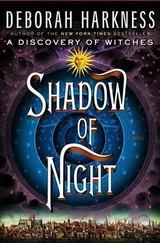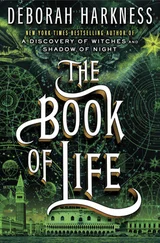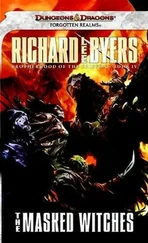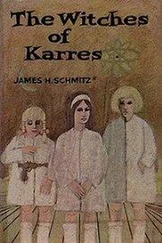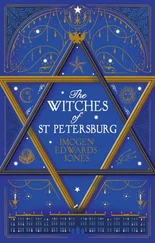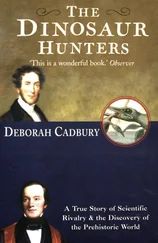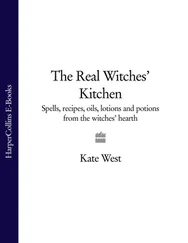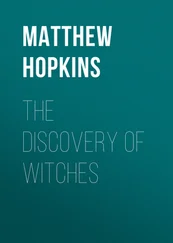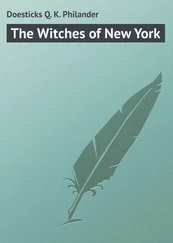“In other words, Matthew,” Miriam interjected tartly, “Ashmole 782 is not just about origins, nor is it just about evolution and extinction. It’s about reproduction.”
I scowled. “Nonsense.”
“You may think it’s nonsense, Diana, but it’s clear to me. Vampires and witches may be able to have children together after all. So might other mixed partners.” Miriam sat back in her chair triumphantly, silently inviting Matthew to explode.
“But vampires can’t reproduce biologically,” Em said. “They’ve never been able to. And different species can’t mix like that.”
“Species change, adapting to new circumstances,” said Marcus. “The instinct to survive through reproduction is a powerful one—certainly powerful enough to cause genetic changes.”
Sarah frowned. “You make it sound like we’re going extinct.”
“We might be.” Matthew pushed the test results into the center of the table along with the notes and the page from Ashmole 782. “Witches are having fewer children and possess diminishing powers. Vampires are finding it harder to take a warmblood through the process of rebirth. And the daemons are more unstable than ever.”
“I still don’t see why that would allow vampires and witches to share children,” Em said. “And if there is a change, why should it begin with Diana and Matthew?”
“Miriam began to wonder while watching them in the library,” Marcus explained.
“We’ve seen vampires exhibit protective behavior before when they want to shield their prey or a mate. But at some point other instincts—to hunt, to feed—overwhelm the urge to protect. Matthew’s protective instincts toward Diana just got stronger,” said Miriam. “Then he started a vampire’s equivalent of flashing his plumage, swooping and diving in the air to attract attention away from her.”
“That’s about protecting future children,” Marcus told his father. “Nothing else makes a predator go to those lengths.”
“Emily’s right. Vampires and witches are too different. Diana and I can’t have children,” Matthew said sharply, meeting Marcus’s eyes.
“We don’t know that. Not absolutely. Look at the spadefoot toad.” Marcus rested his elbows on the table’s surface, weaving his fingers together with a loud crack of his knuckles.
“The spadefoot toad?” Sarah picked up the picture of the chemical wedding, her fingers crumpling the edge. “Wait a minute. Is Diana the lion, the toad, or the queen in this picture?”
“She’s the queen. Maybe the unicorn, too.” Marcus gently pried the page from my aunt’s fingers and went back to amphibians. “In certain situations, the female spadefoot toad will mate with a different—though not completely unrelated—species of toad. Her offspring benefit from new traits, like faster development, that help them survive.”
“Vampires and witches are not spadefoot toads, Marcus,” Matthew said coldly. “And not all of the changes that result are positive.”
“Why are you so resistant?” Miriam asked impatiently. “Cross-species breeding is the next evolutionary step.”
“Genetic supercombinations—like those that would occur if a witch and a vampire were to have children—lead to accelerated evolutionary developments. All species take such leaps. It’s your own findings we’re reporting back to you, Matthew,” said Marcus apologetically.
“You’re both ignoring the high mortality associated with genetic super-combinations. And if you think we’re going to test those odds with Diana, you are very much mistaken.” Matthew’s voice was dangerously soft.
“Because she’s a chimera—and AB-negative as well—she may be less likely to reject a fetus that’s half vampire. She’s a universal blood recipient and has already absorbed foreign DNA into her body. Like the spadefoot toad, she might have been led to you by the pressures of survival.”
“That’s a hell of a lot of conjecture, Marcus.”
“Diana is different, Matthew. She’s not like other witches.” Marcus’s eyes flickered from Matthew to me. “You haven’t looked at her mtDNA report.”
Matthew shuffled the pages. His breath came out in a hiss.
The sheet was covered in brightly covered hoops. Miriam had written across the top in red ink “Unknown Clan,” accompanied by a symbol that looked like a backward E set at an angle with a long tail. Matthew’s eyes darted over the page, and the next.
“I knew you’d question the findings, so I brought comparatives,” Miriam said quietly.
“What’s a clan?” I watched Matthew carefully for a sign of what he was feeling.
“A genetic lineage. Through a witch’s mitochondrial DNA, we can trace descent back to one of four women who were the female ancestors of every witch we’ve studied.”
“Except you,” Marcus said to me. “You and Sarah aren’t descended from any of them.”
“What does this mean?” I touched the backward E.
“It’s an ancient glyph for heh, the Hebrew number five.” Matthew directed his next words to Miriam. “How old is it?”
Miriam considered her words carefully. “Clan Heh is old—no matter which mitochondrial-clock theory you adhere to.”
“Older than Clan Gimel?” Matthew asked, referring to the Hebrew word for the number three.
“Yes.” Miriam hesitated. “And to answer your next question, there are two possibilities. Clan Heh could just be another line of descent from mtLilith.”
Sarah opened her mouth to ask a question, and I quieted her with a shake of my head.
“Or Clan Heh could descend from a sister of mtLilith—which would make Diana’s ancestor a clan mother, but not the witches’ equivalent of mtEve. In either case it’s possible that without Diana’s issue Clan Heh will die out in this generation.”
I slid the brown envelope from my mother in Matthew’s direction. “Could you draw a picture?” No one in the room was going to understand this without visual assistance.
Matthew’s hand sped over the page, sketching out two sprawling diagrams. One looked like a snake, the other branched out like the brackets for a sports tournament. Matthew pointed to the snake. “These are the seven known daughters of mitochondrial Eve—mtEve for short. Scientists consider them to be the most recent common matrilineal ancestors of every human of Western European descent. Each woman appears in the DNA record at a different point in history and in a different region of the globe. They once shared a common female ancestor, though.”
“That would be mtEve,” I said.
“Yes.” He pointed at the tournament bracket. “This is what we’ve uncovered about the matrilineal descent of witches. There are four lines of descent, or clans. We numbered them in the order we found them, although the woman who was mother to Clan Aleph—the first clan we discovered —lived more recently than the others.”
“Define ‘recently,’ please,” Em requested.
“Aleph lived about seven thousand years ago.”
“Seven thousand years ago?” Sarah said incredulously. “But the Bishops can only trace our female ancestors back to 1617.”
“Gimel lived about forty thousand years ago,” Matthew said grimly. “So if Miriam is right, and Clan Heh is older, you’ll be well beyond that.”
“Damn,” Sarah breathed again. “Who’s Lilith?”
“The first witch.” I drew Matthew’s diagrams closer, remembering his cryptic response in Oxford to my asking if he was searching for the first vampire. “Or at least the first witch from whom present-day witches can claim matrilineal descent.”
“Marcus is fond of the Pre-Raphaelites, and Miriam knows a lot of mythology. They picked the name,” Matthew said by way of explanation.
“The Pre-Raphaelites loved Lilith. Dante Gabriel Rossetti described her as the witch Adam loved before Eve.” Marcus’s eyes turned dreamy. “‘So went / Thy spell through him, and left his straight neck bent / And round his heart one strangling golden hair.’”
Читать дальше

